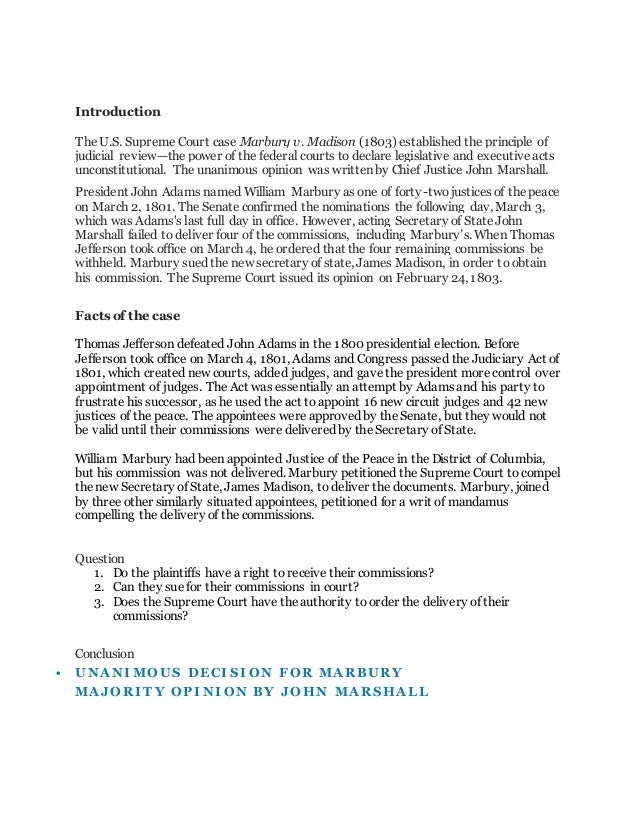
Judicial review
- 1. Introduction The U.S. Supreme Court case Marbury v. Madison (1803) established the principle of judicial review—the power of the federal courts to declare legislative and executive acts unconstitutional. The unanimous opinion was written by Chief Justice John Marshall. President John Adams named William Marbury as one of forty-twojustices of the peace on March 2, 1801. The Senate confirmed the nominations the following day, March 3, which was Adams's last full day in office. However, acting Secretary of State John Marshall failed to deliver four of the commissions, including Marbury’s. When Thomas Jefferson took office on March 4, he ordered that the four remaining commissions be withheld. Marbury sued the new secretary of state, James Madison, in order to obtain his commission. The Supreme Court issued its opinion on February 24, 1803. Facts of the case Thomas Jefferson defeated John Adams in the 1800 presidential election. Before Jefferson took office on March 4, 1801, Adams and Congress passed the Judiciary Act of 1801, which created new courts, added judges, and gave the president more control over appointment of judges. The Act was essentially an attempt by Adams and his party to frustrate his successor, as he used the act to appoint 16 new circuit judges and 42 new justices of the peace. The appointees were approved by the Senate, but they would not be valid until their commissions were delivered by the Secretary of State. William Marbury had been appointed Justice of the Peace in the District of Columbia, but his commission was not delivered. Marbury petitioned the Supreme Court to compel the new Secretary of State, James Madison, to deliver the documents. Marbury, joined by three other similarly situated appointees, petitioned for a writ of mandamus compelling the delivery of the commissions. Question 1. Do the plaintiffs have a right to receive their commissions? 2. Can they sue for their commissions in court? 3. Does the Supreme Court have the authority to order the delivery of their commissions? Conclusion U N A N I MO U S DE C I S I O N F O R MA RBU RY MA J O RI T Y O P I N I O N BY J O H N MA RS H A L L
- 2. Though Marbury was entitled to it, the Court was unable to grant it because Section 13 of the Judiciary Act of 1789 conflicted with Article III Section 2 of the U.S. Constitution and was therefore null and void. The Court found that Madison’s refusal to deliver the commission was illegal, but did not order Madison to hand over Marbury’s commission via writ of mandamus. Instead, the Court held that the provision of the Judiciary Act of 1789 enabling Marbury tobring his claim to the Supreme Court was itself unconstitutional, since it purported to extend the Court’s original jurisdiction beyond that which Article III, Section 2, established. Marshall expanded that a writ of mandamus was the proper way to seek a remedy, but concluded the Court could not issue it. Marshall reasoned that the Judiciary Act of 1789 conflicted with the Constitution. Congress did not have power to modify the Constitution through regular legislation because Supremacy Clause places the Constitution before the laws. In so holding, Marshall established the principle of judicial review, i.e., the power to declare a law unconstitutional. Impact Marshall’s masterful verdict has been widely hailed. In the face of attacks on the judiciary launched by Jefferson and his followers, Marshall needed to make a strong statement tomaintain the status of the Supreme Court as the head of a coequal branch of government. By asserting the power to declare acts of Congress unconstitutional (which the court would not exercise again for more than half a century), Marshall claimed for the court a paramount position as interpreter of the Constitution. Although Marbury v. Madison set an abiding precedent for the court’s power in that area, it did not end debate over the court’s purview, which has continued for more than two centuries. In fact, it is likely that the issue will never be fully resolved. But the fact remains that the court has claimed and exercised the power of judicial review through most of U.S. history—and, as Judge Learned Hand noted more than a century later, the country is used to it by now. Moreover, the principle fits well with the government’s commitment to checks and balances. Few jurists can argue with Marshall’s statement of principle near the end of his opinion, “that a law repugnant to the constitution is void, and that courts, as well as other departments, are bound by that instrument.”